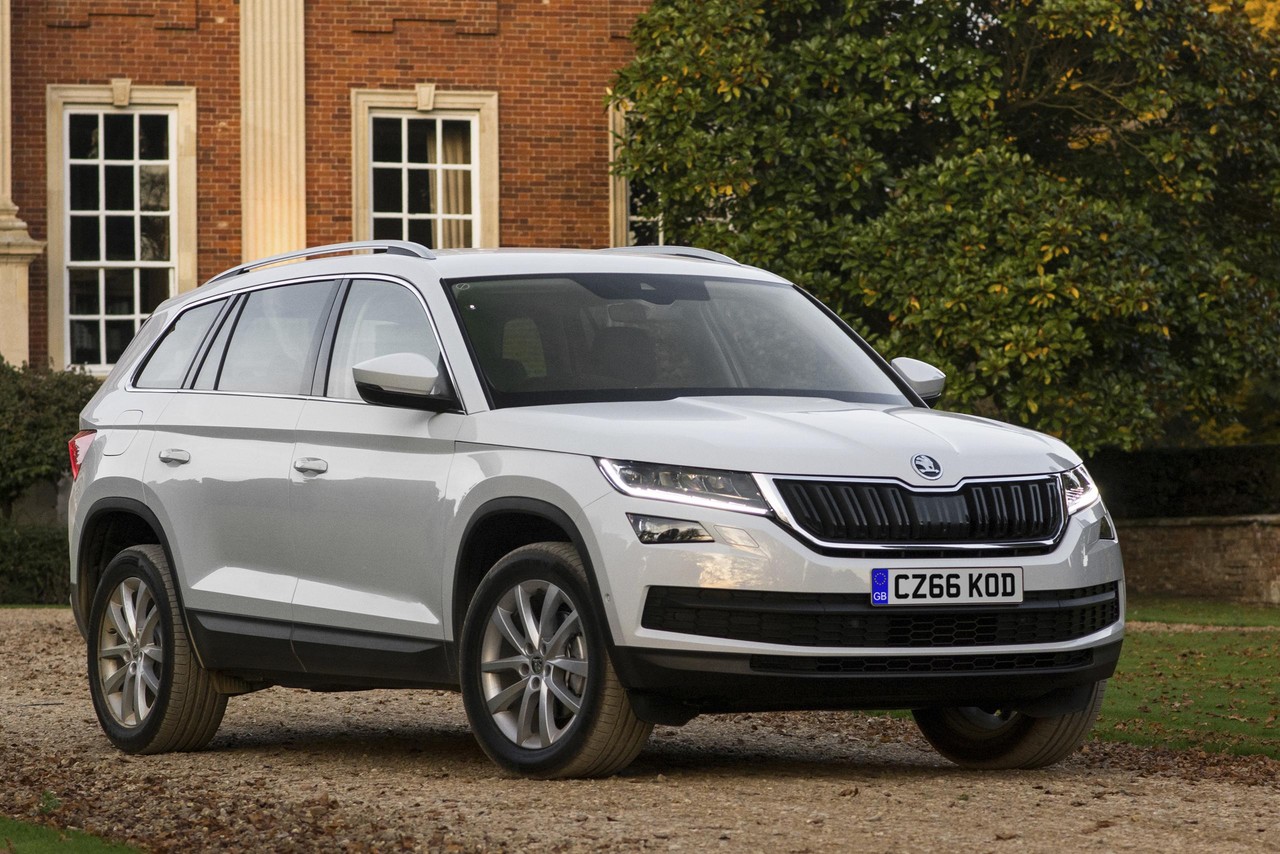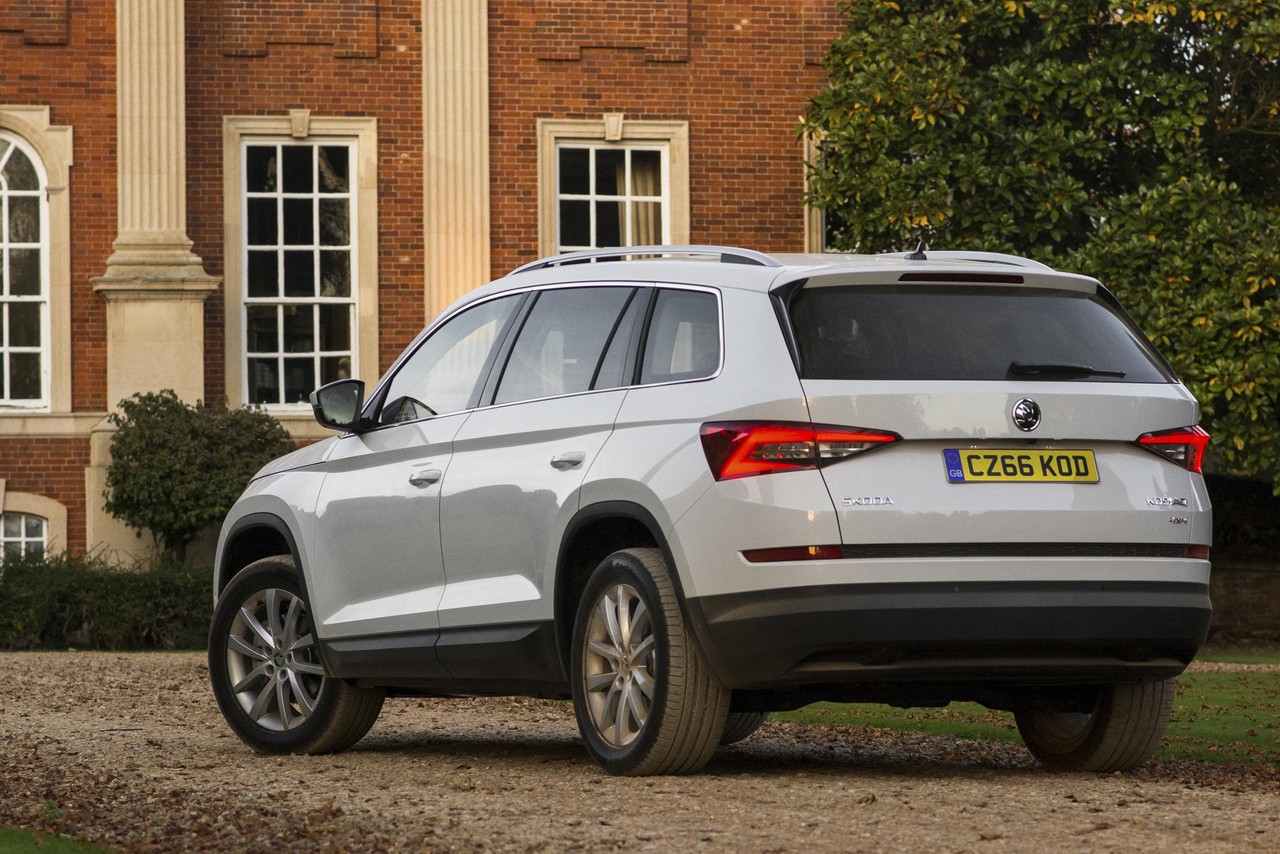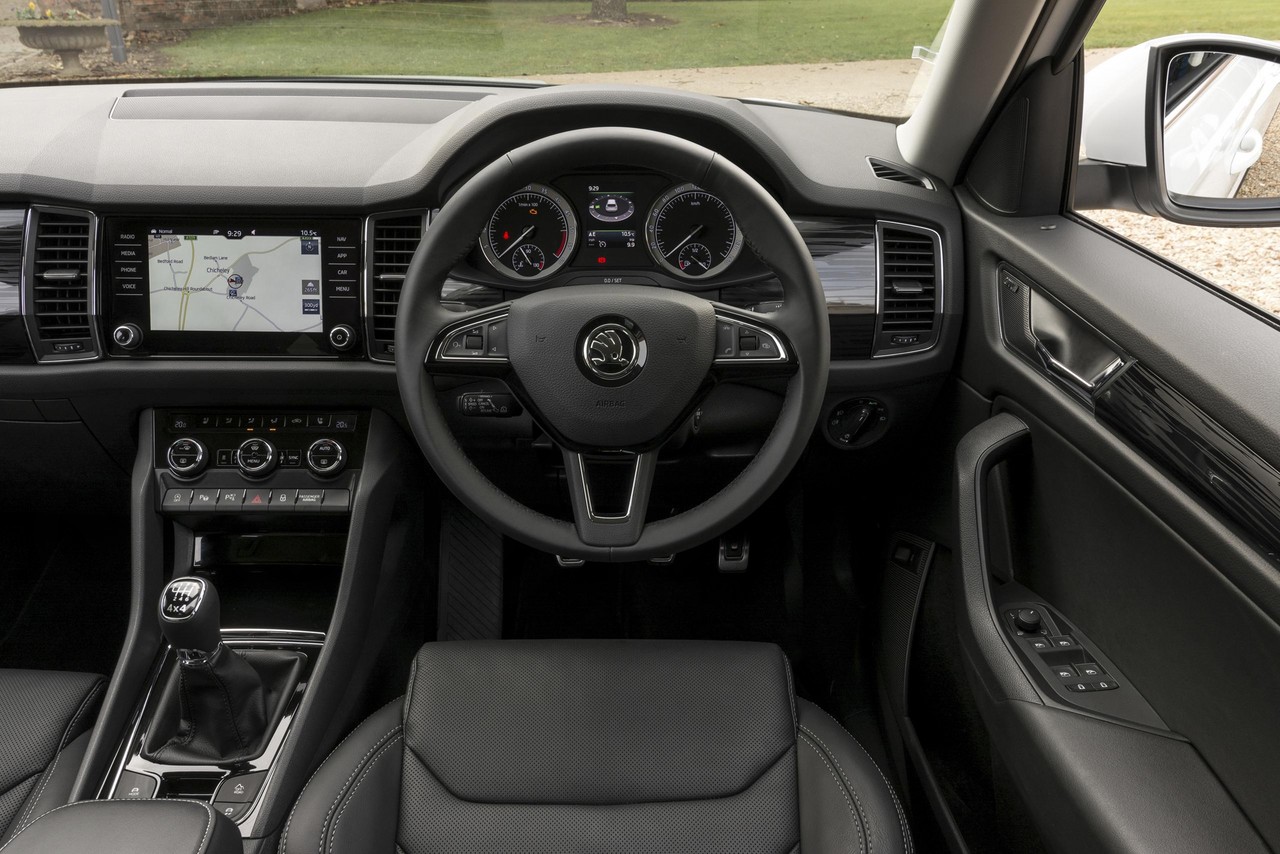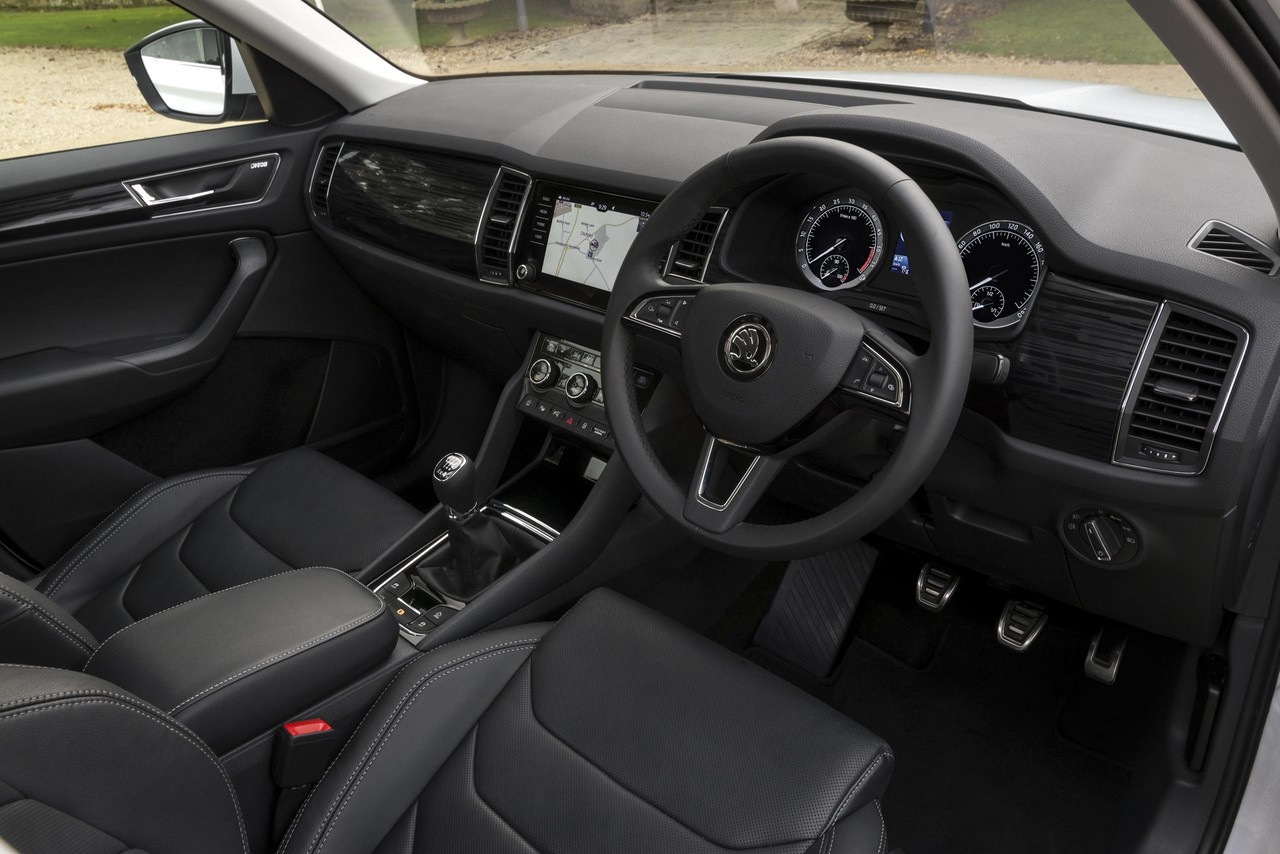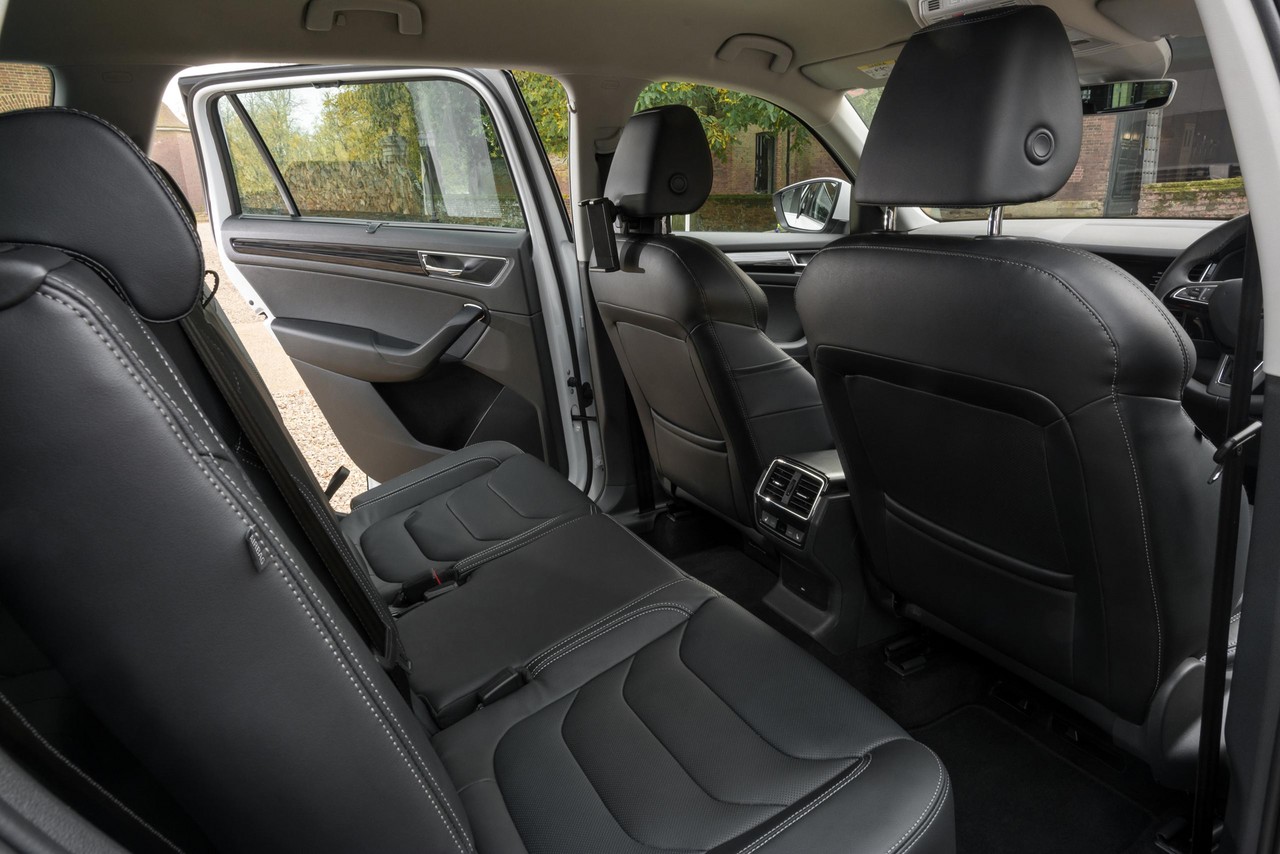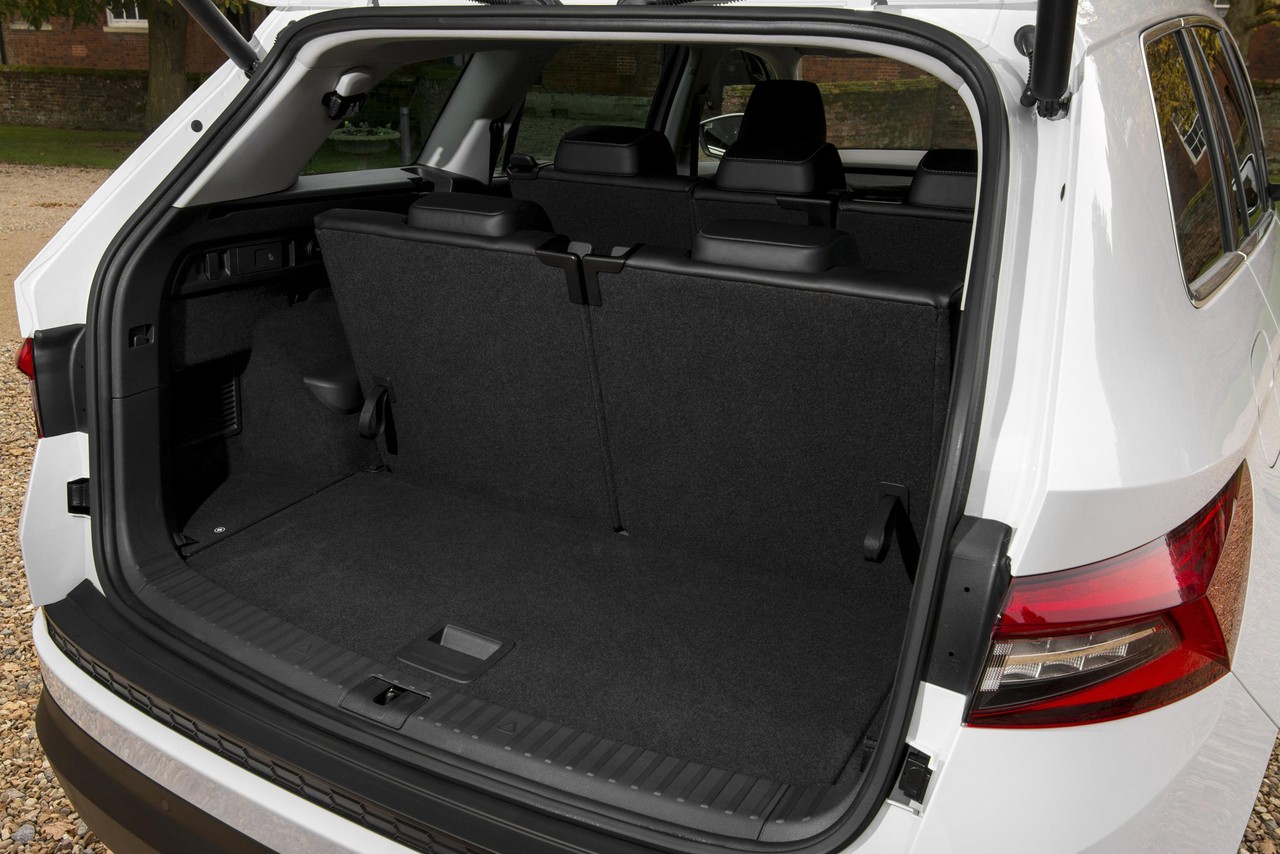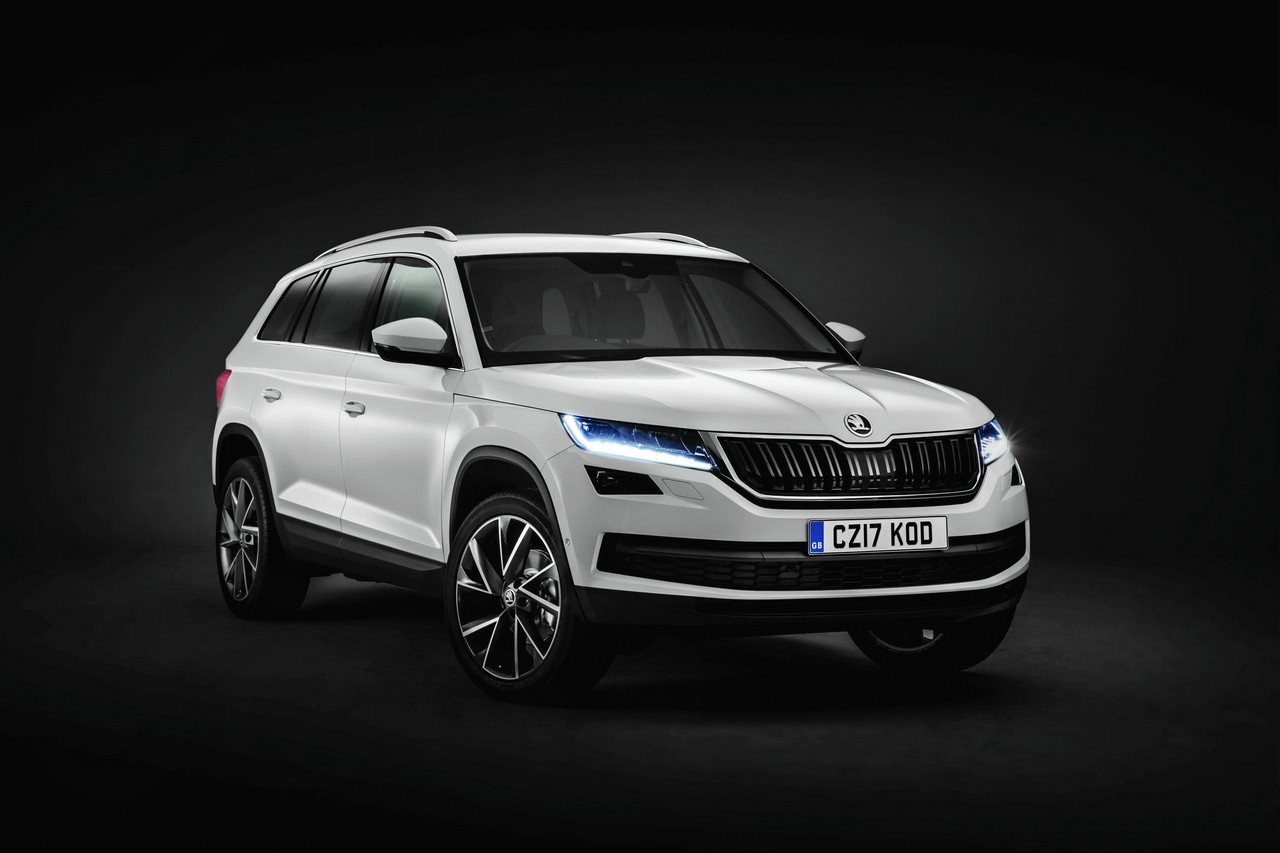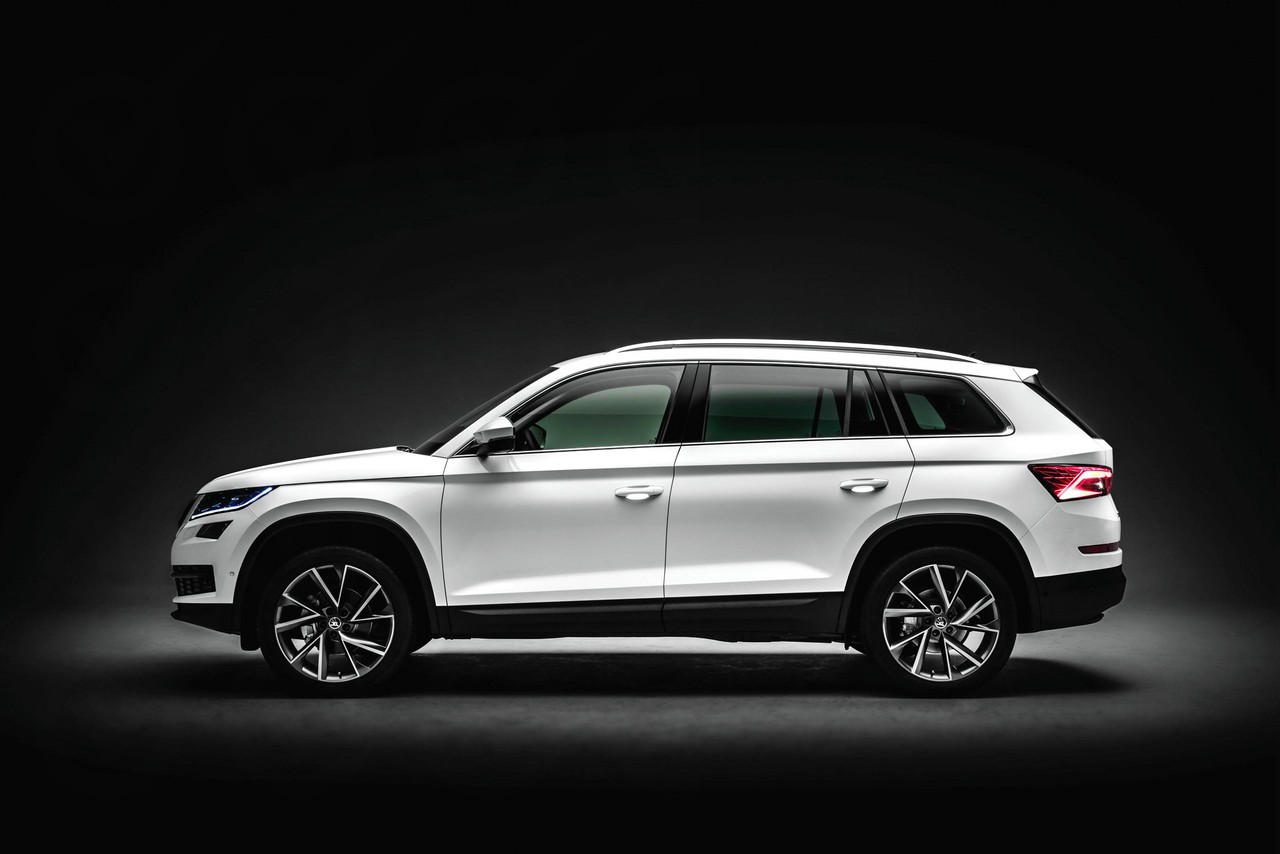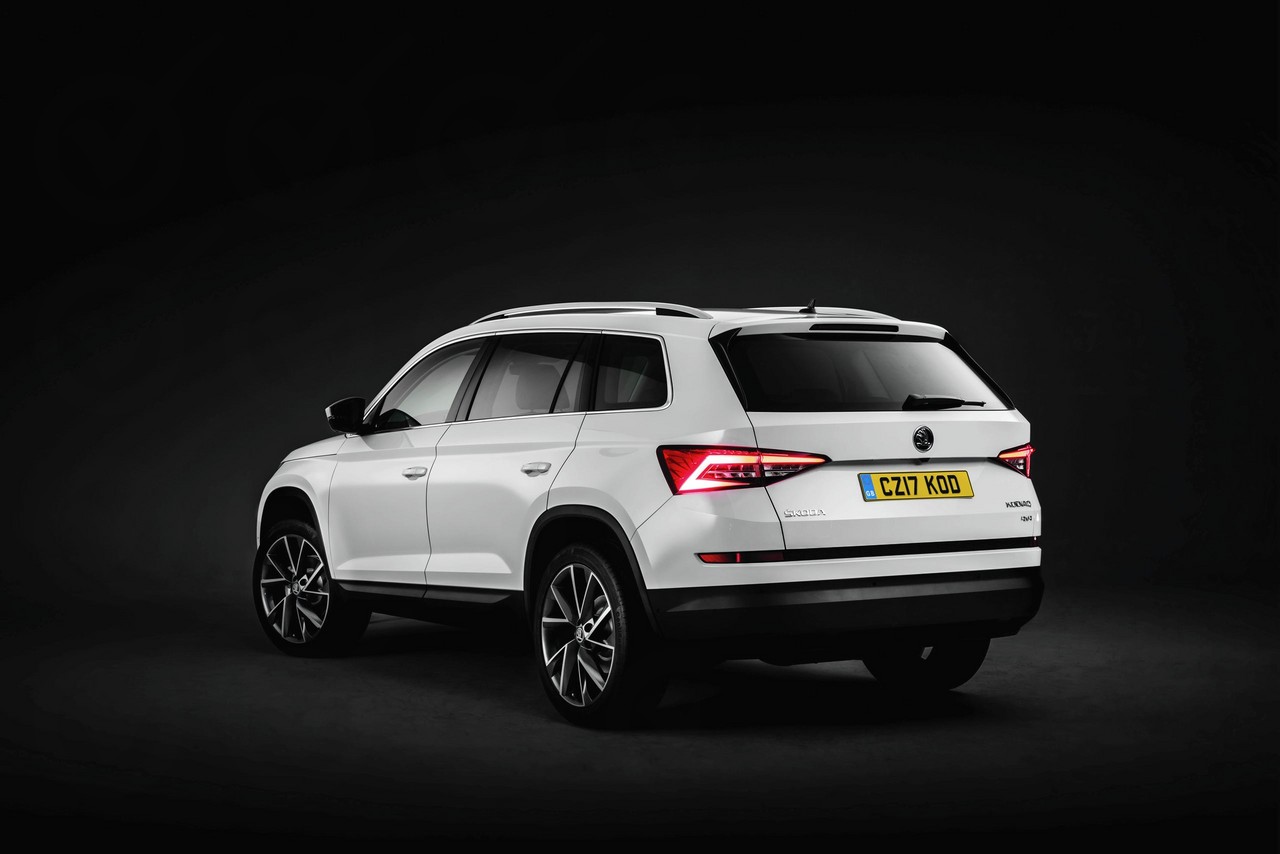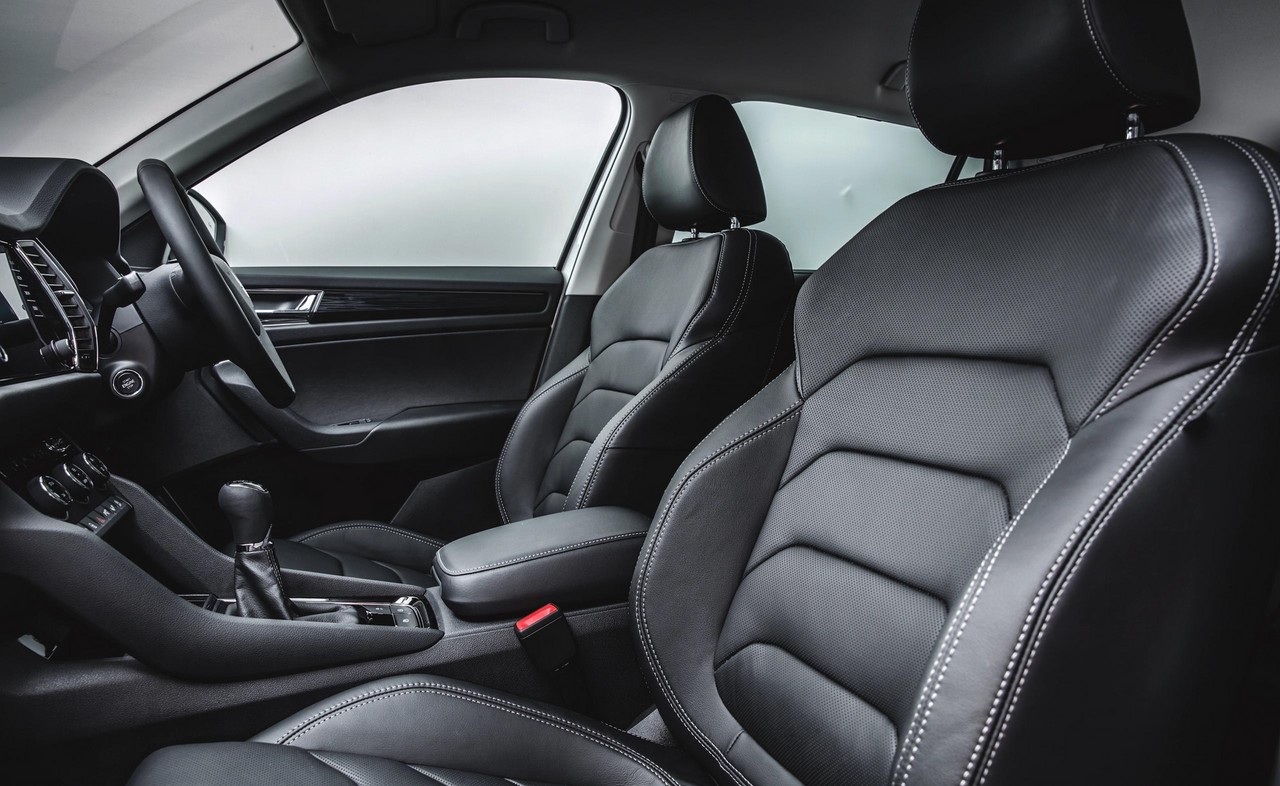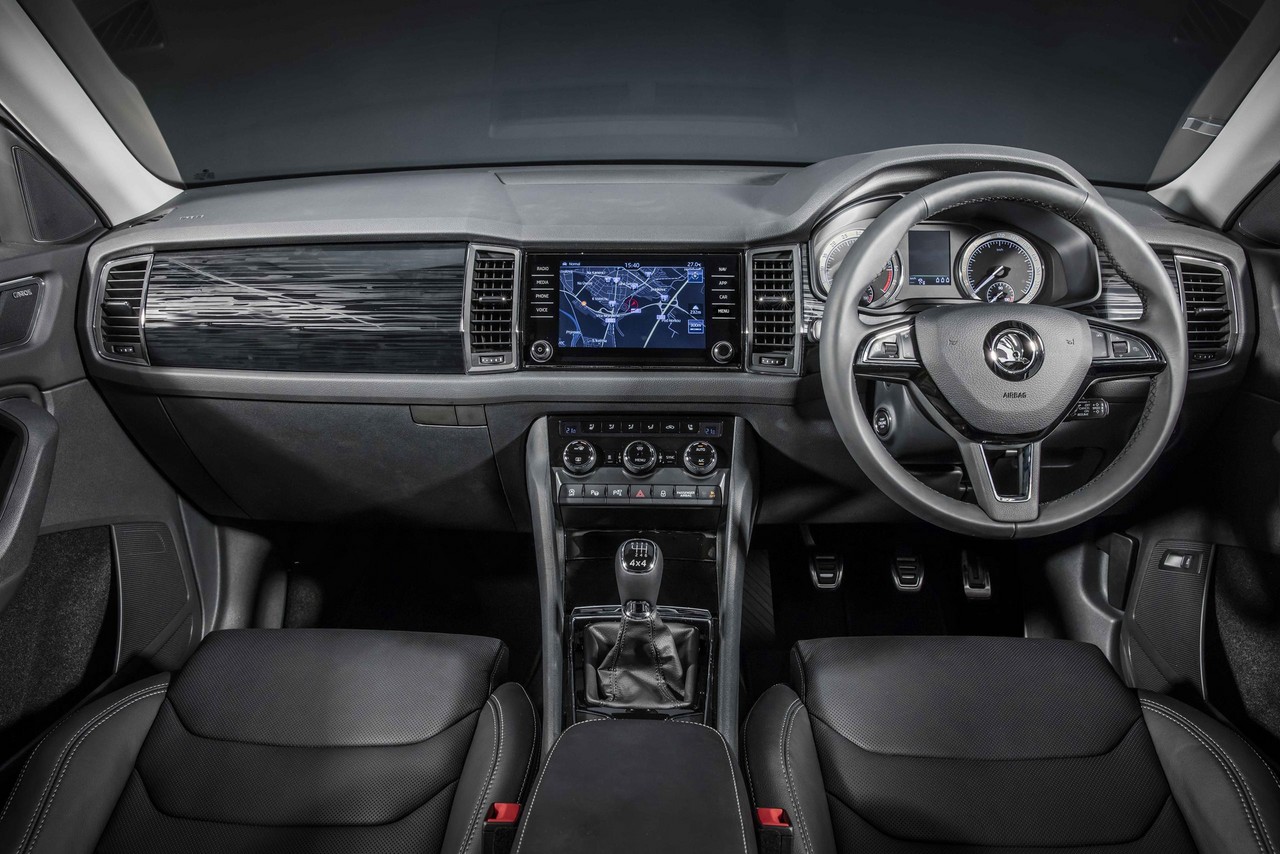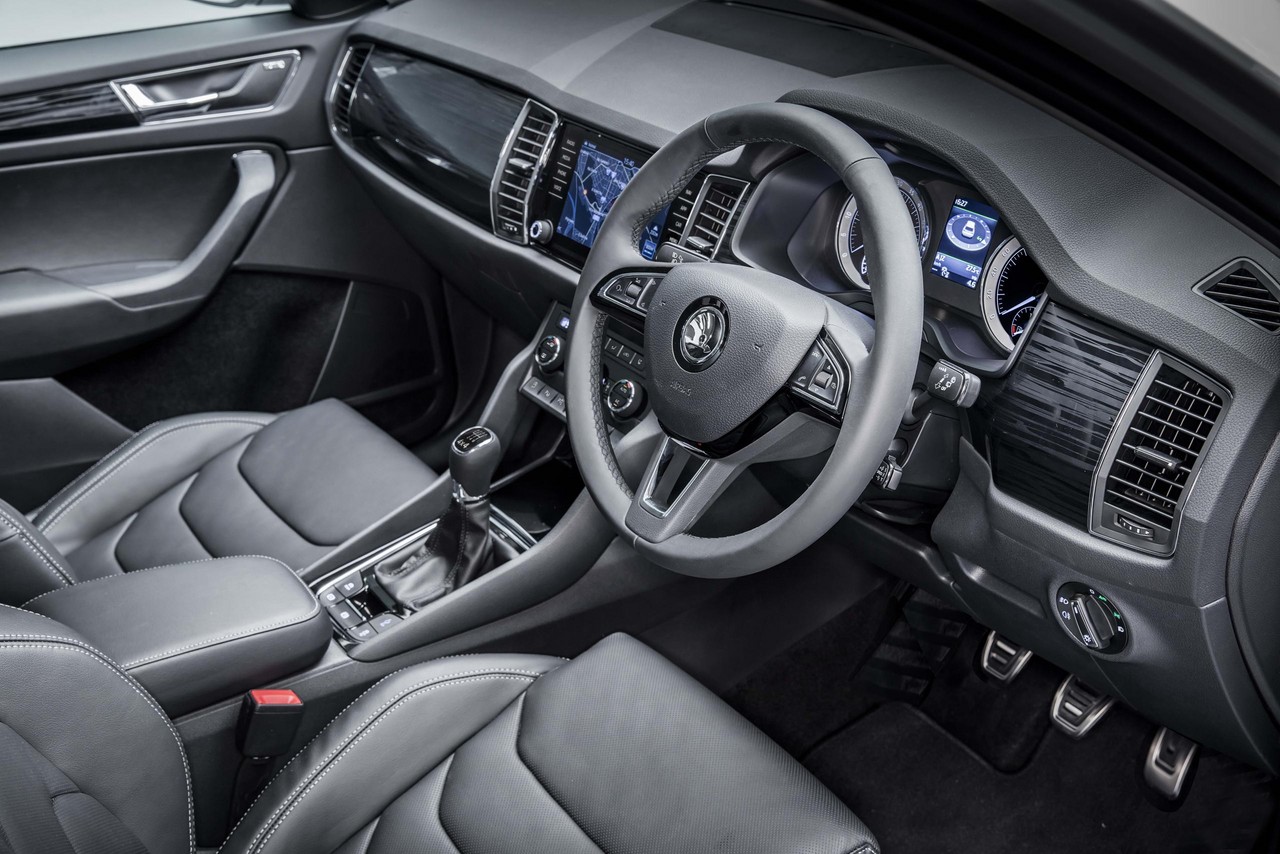
- Spacious interior for front and second row occupants
- Comfortable front seats
- ‘Columbus’ infotainment and navigation is intuitive and easy to use
- Front Assist and Emergency Braking fitted as standard
- Suspension provides good body control…
- … though low-speed ride is unsettled and would benefit from 65 profile tyres
- Light steering is inconsistently weighted (and bereft of feel)
- Performance from 132TSI engine is only adequate
- DSG can provide abrupt gearshifts
- Third-row seats are cramped for adults
- Why are certain safety technologies only available in a ‘Luxury Pack’?
Overview
Released in Australia in May 2017, the Skoda Kodiaq was a large, seven-seat SUV. Manufactured in Kvasiny, Czech Republic, the all-wheel drive Skoda Kodiaq was initially offered with 2.0-litre turbocharged petrol engine, though a 2.0-litre turbo diesel engine was available to order August 2017.
All engines for the Skoda Kodiaq complied with Euro 6 emissions standards and had Stop-Start systems that enabled them to shut down when the vehicle was stationary in traffic. For Kodiaq models with the seven-speed ‘Direct Shift Gearbox’ (DSG), the driver could select from the automatic D and S modes, or perform manual gearshifts using the steering wheel paddles. In Eco mode, drive disengaged when the driver removed their foot from the accelerator and vehicle speed was above 20 km/h – this coasting function avoided the effect of engine braking to improve fuel economy.
Skoda Kodiaq RS
The Skoda Kodiaq RS will be available to order from late 2019. The Kodiaq RS is powered by a 2.0-litre biturbo diesel engine (see details below) and can accelerate from rest to 100 km/h in 7.0 seconds. According to Skoda, key features of the Kodiaq RS include its 20-inch ‘Xtreme’ alloy wheels, red brake callipers, black door mirrors and roof rails, leather interior and digital instrument cluster.
| Variant | Engine | Trans. | Peak power | Peak torque |
|---|---|---|---|---|
| 132TSI AWD | 1984 cc CZP turbo petrol I4 | 7sp DSG | 132 kW at 3900-6000 rpm | 320 Nm at 1400-3940 rpm |
| 140TDI AWD | 1968 cc DFH turbo diesel I4 | 7sp DSG | 140 kW at 3500-4000 rpm | 400 Nm at 1750-3250 rpm |
| 2.0 TDI RS | 1968 cc biturbo diesel I4 | 7sp DSG | 176 kW at 4000 rpm | 500 Nm at 1750-2500 rpm |
All-wheel drive system
The Skoda Kodiaq had a Haldex 5 all-wheel drive system which consisted of an electronically controlled and hydraulically actuated multi-plate clutch coupling (located in front of the rear axle differential at the end of the prop shaft). When in overrun or at low load, the rear axle was decoupled to reduce fuel consumption. If, however, there was a loss of front wheel traction or such a loss was anticipated by on-board sensors, then an electro-hydraulic oil pump applied pressure to the clutch plates to transfer up to 50 per cent of the engine’s torque to the rear wheels (for a 50:50 front:rear torque split).
Body and dimensions
The Skoda Kodiaq is underpinned by Volkswagen AG’s MQB platform; while this is shared with the Volkswagen 5NA Tiguan , the Skoda Kodiaq had a 118 mm longer wheelbase (at 2791 mm). Furthermore, the Skoda Kodiaq was 4697 mm long, 1882 mm wide and 1676 mm tall (including roof rails), while its drag co-efficient is 0.336 Cd. The Kodiaq 132TSI and 140TDI had kerb weights of 1707 kg and 1761 kg, respectively.
Inside, the Skoda Kodiaq’s second row seats could be folded in a 60:40 ratio, slid up to 180 mm lengthways for easier access to the third row seats and moved horizontally; the angle of the backrest could also be adjusted for each seat. Luggage capacity for the Skoda Kodiaq was 270 litres with the rear seats in position, though this increased to 630 litres when the rear seats were folded down.
Suspension
The Skoda Kodiaq had MacPherson strut front suspension with lower A-arms and independent, four-link rear suspension which consisted of a longitudinal link and three transverse links. As part of the extra-cost ‘Tech Pack’, the Kodiaq could be specified with ‘Adaptive Chassis Control’ which consisted of electronically controlled dampers that varied damping resistance according to road conditions and driver behaviour; the driver could also select from Comfort, Normal and Sport modes.
Steering
The Skoda Kodiaq had rack-and-pinion steering with electric power assistance.
Safety equipment
Standard safety equipment for the Skoda Kodiaq included dual front airbags, a driver’s knee airbag, seat-mounted side airbags for the front and second row seats, curtain airbags for front and second row occupants, ABS, electronic brake force distribution, electronic stability control, traction control and front seatbelts with pre-tensioners and load limiters.
As standard, the Skoda Kodiaq was fitted with the following active safety technologies –
- Front Assist: operating at speeds above 30 km/h, Front Assist used a radar sensor to detect if the Skoda Kodiaq was closing too fast on the vehicle ahead. If this occurred, Front Assist 1) provided audible and visual warnings to the driver; 2) brought the brake pads into contact with the brake discs in preparation for an emergency stop; and, 3) provided a jolting brake application to alert the driver. If the driver failed to respond, Front Assist would apply the brakes automatically to avoid or reduce the severity a collision;
- City Emergency Brake: operated at speeds below 30 km/h and used a radar sensor and front camera to monitor the area ahead for vehicles and pedestrians. If a collision was anticipated, the driver is alerted via visual and audible warnings, followed by jolting brake application. If the driver failed to respond, the system would initiate emergency braking;
- Adaptive Cruise Control (ACC): when cruise control was engaged at speeds between 30 km/h and 160 km/h, ACC used a radar sensor to maintain a safe distance from the vehicle in front, controlling engine speed and applying the brakes as necessary. When the road ahead was clear, ACC could also cause the vehicle to accelerate up to its cruising speed;
- Passenger Protect Assist: operating at speeds above 30 km/h, Passenger Protect Assist could detect when an emergency manoeuvre was being performed and would use the electrical front seatbelt pre-tensioners to remove slack from the seatbelts. In cases where high lateral accelerations were detected, Passenger Protect Assist would also close the side windows and sunroof (where fitted) to prevent objects coming into the passenger compartment in the event of a collision;
- Multi-Collision Brake: activated when two independent sensors detected that a collision had occurred and that the driver had not responded. In these circumstances, the brakes were applied to achieve controlled deceleration to a speed of 10 km/h to minimise the risk of the vehicle being involved in secondary collisions and their severity; and,
- Driver Alert: monitored driver behavior at speeds in excess of 65 km/h for signs of fatigue. If detected, a tone would sound and a warning would appear in the multi-function display.
The optional, extra-cost ‘Luxury Pack’ included the following safety technologies –
- Lane Assist: operated at speeds over 65 km/h and used a camera that was positioned in the base of the rear-view mirror to detect lane markings. If the driver was determined to have unintentionally departed from the lane, the system automatically initiated corrective steering. If no steering action was detected from the driver, a warning signal sounds and the message ‘Lane Assist – please take over steering’ would appear on the multi-function display;
- Emergency Assist: an extension of ACC and Lane Assist, Emergency Assist could bring the vehicle to rest if no steering wheel movement or driver activity was detected. Initially, a warning tone would sound, followed by a ‘short swerve’. If there was still no response from the driver, the vehicle would be braked to rest and the hazard lights automatically activated;
- Side Assist – Blind Spot Detection: active at speeds over 10 km/h, Side Assist used two radar systems in the lower part of the rear bumper to monitor the area beside and up to 20 metres behind the Skoda Kodiaq. When the system detected a vehicle in the driver’s blind spot or approaching from behind, an LED symbol would illuminate in the door mirror to alert the driver. If the driver indicated to change lanes in the direction of the detected vehicle, the LED would flash to alert driver; and,
- Rear Traffic Alert: when reversing out of parking bays, Rear Traffic Alert could detect vehicles approaching laterally that could cross the Skoda Kodiaq’s projected path. If detected, an acoustic signal would warn of a possible collision, while the side from which the vehicle was approaching would be shown on the infotainment display (initially in yellow and then in red). If necessary, the brakes would be automatically applied to prevent the driver from continuing to reverse out of the parking bay.
As standard, the Skoda Kodiaq had an ‘active bonnet’ which, in the event of a frontal collision with a pedestrian or cyclist, would rise by 50 mm within 22 milliseconds to provide additional clearance over ‘hard points’ in the engine bay and reduce impact severity.
Euro NCAP testing
In Euro NCAP testing , the Skoda Kodiaq 2.0 TDI received a five star safety rating which included a 92 per cent adult occupant protection rating and a 77 per cent child occupant protection rating. In the frontal offset test, protection of the driver’s head, thighs and feet were rated as good, though lower leg protection was rated as adequate and chest protection as marginal. Maximum points, however, were awarded in the side impact and pole tests.
Brakes
The Skoda Kodiaq had 340 mm by 30 mm ventilated front brake discs and 300 mm by 12 mm solid rear discs.
Features: Skoda Kodiaq
Standard features for the Australian-delivered Skoda Kodiaq included 7.0J x 19-inch ‘Triglav’ alloy wheels with 235/50 R19 tyres, Skoda’s ‘Columbus’ infotainment system with an 8.0-inch touchscreen and navigation, an eight speaker sound system, an auxiliary-in socket (3.5 mm), USB interface and two SD card slots, Bluetooth mobile phone connectivity with voice control and audio streaming, Apple CarPlay and Android Auto smartphone integration, dual-zone climate control air conditioning (‘Climatronic’), Alcantara and leather-appointed seat upholstery, cruise control, LED headlights with Adaptive Front Lighting, LED daytime running lights, LED front fog lights with cornering function, a rear view camera, dusk-sensing headlights, rain-sensing wipers, a leather multi-function steering wheel, 60:40 split folding second-row seats, 50:50 split and flat folding third row seats, remote central locking with proximity key (i.e. keyless entry), power adjustable and heated door mirrors, power windows, a height and reach adjustable steering wheel, height adjustable front seats, an auto-dimming rear view mirror, push-button start, 12 volt power sockets (in front of the gear stick, the centre console and luggage compartment), silver-coloured roof rails, a power-operated tailgate, LED interior ambient lighting, illuminated vanity mirrors, rear privacy glass, tyre pressure monitoring, a trip computer, an alarm and immobiliser.
2018 model year update
In August 2017, the Skoda Kodiaq was updated for the ‘2018 model year’. As part of the update, standard features for the Skoda Kodiaq were extended to include a 9.2-inch touchscreen (previously 8.0-inch) with gesture control, a digital radio tuner (DAB+) and adjustable headrests for second-row seat occupants that were similar to those on airplanes (the ‘Sleep Pack’).
Skoda Kodiaq Sportline
The Skoda Kodiaq Sportline was released in Australia in March 2018. Available in 132TSI and 140TDI variants, the Kodiaq Sportline could be identified by its 20-inch ‘Vega’ anthracite-coloured alloy wheels, ‘Velvet Red’ paint finish and ‘SportLine Design Package’ which consisted of black door mirrors, black roof rails, black window frames, black ceiling trim and gloss black radiator grille frame.
Inside, the Kodiaq Sportline had a power adjustable driver’s seat with memory function, auto-dimming door mirrors with memory function, combination Alcantara/leather sports seats with silver-coloured stitching, steering wheel gearshift paddles, Alcantara door panel trim, a black rooflining and aluminium pedals.
